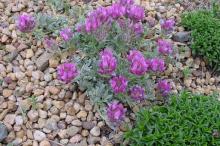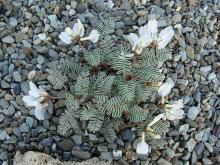Over the decades I'm sure I have grown several dozen milkvetches in my various gardens. As gorgeous as many of the American species are, I have noticed that the Eurasian ones are more apt to stick around. This Turkish species came to me from Jim and Jenny Archibald over 20 years ago. I can't remember if it is Astragalus alyssoides or A. alyssifolia (it was one of the two)...It certainly doesn't look like any alyssum I grow! My original plants grew for almost a decade at my last home. I grew some from seed when I moved to Quince and they are still with me ten years later. I must remember to collect a few more seeds or try some cuttings: it's a sweet little plant!
Comments
Re: Serviceable Milkvetch
Might it be Astragalus angustifolius, Trond?
This supposed specimen of Astragalus angustifolius, grown in captivity and in regular soil (and even in less direct sun than it might prefer), is not so alpine in character. (Apologies for the fuzzy picture.)
Re: Serviceable Milkvetch
Over the decades I'm sure I have grown several dozen milkvetches in my various gardens. As gorgeous as many of the American species are, I have noticed that the Eurasian ones are more apt to stick around. This Turkish species came to me from Jim and Jenny Archibald over 20 years ago. I can't remember if it is Astragalus alyssoides or A. alyssifolia (it was one of the two)...It certainly doesn't look like any alyssum I grow! My original plants grew for almost a decade at my last home. I grew some from seed when I moved to Quince and they are still with me ten years later. I must remember to collect a few more seeds or try some cuttings: it's a sweet little plant!
Nice Astrag! I couldn't find either name in IPNI (sometimes they miss names), but did find Astragalus alyssoides in parts of C. Asia, including Turkey. The following link has some photos from the online Van Flora in Turkey. With "alyssifolia", I think you have Phlox in your thoughts :D
http://vanherbaryum.yyu.edu.tr/flora/famgenustur/fab/astragalus/aly/inde...
Re: Serviceable Milkvetch
Might it be Astragalus angustifolius, Trond?
This supposed specimen of Astragalus angustifolius, grown in captivity and in regular soil (and even in less direct sun than it might prefer), is not so alpine in character. (Apologies for the fuzzy picture.)
I thought it might be angustifolius but according to a Turkish flora I have (not good) it is at least one or two other candidates.
Re: Serviceable Milkvetch
What are the other candidates, Trond?
Re: Serviceable Milkvetch
Trond, are you using the Turkish flora TÜBİVES database (Turkish Plants Data Service)? It's an excellent resource that I've become aware of recently. Lori, as a "researcher" you'll like this one too. Here's the link:
http://turkherb.ibu.edu.tr/index.php?sayfa=200
If you know where a plant was collected or found in Turkey, you can click on the interactive map of Vilayets (provinces) and it gives you a complete listing of taxa, sorted by family and genus, found in that province. Or, you can use a Grid system to search. Or search by a keyword, such as Astragalus... wow, 447 accepted astragali in Turkey! If based on plant characteristics, such as in your white astragalus example, you can narrow it down to some likely ID candidates, you can use the "Taxa Comparison" option. So, you can click on "taxa Comparison", select Fabaceae > List Taxa > find Astragalus from the genus list, then check the boxes of species you want to compare. I did this with the four A. angustifolius subspecies and varieties, and uploaded a screen capture. Very cool.
Notes:
alttür= subspecies
varyete = variety
Some plant taxa that have widespread distribution in Turkey might not be recorded yet on a province level, thus might be missing from the taxa listing by Vilayets, so this thing is still a work in progress.
The other option for Turkish Flora, is to use the Van Flora web site. You'll find a listing of genera and species, with photos and herbarium specimens for some taxa, but unfortunately not for all. Here's the link for Astragalus... maybe 15-20% have detail information links with photos.
http://vanherbaryum.yyu.edu.tr/flora/famgenustur/astragalus.htm
Re: Serviceable Milkvetch
Thank you for that link, Mark - I will bookmark it. Turkey has such a rich flora!
Here's an interesting one - Astragalus gilviflorus. It occurs through SE Alberta. I was not successful at growing it in the front yard years ago (despite it being a plant of the dry prairies), but it has survived in a trough.
Re: Serviceable Milkvetch
What are the other candidates, Trond?
Hello, back in business! Been offline for a week, enervating!
I thought of A barbatus as a likely candidate. A ermineus and hirticalyx are also found in the same area, but they are a little different, maybe.
Re: Serviceable Milkvetch
Panayoti,
I think you might like to add another arrow to your quiver of astragali that perform well in the garden: Astragalus monspessulans.
It handles the northeastern assault of humidity, unexpected days of heavy rain and periods of drought. It's a reliable bloomer and seems to be able to handle any amount of cold. I grow it in sand beds and in screes. It makes seedlings which can be dug up when they're quite small and easily transplanted directly into the garden. The flowers are the color of red wine and the canoe shaped pods also turn red. I'll try and hunt up a photo.
Re: Serviceable Milkvetch
Ann: you are right! I grew this years ago and it did last for years at the Gardens. I must get it back!
Great to see you on the Forum!
Re: Serviceable Milkvetch
Ann: you are right! I grew this years ago and it did last for years at the Gardens. I must get it back!
Great to see you on the Forum!
OK Panayoti. You know where to come and get some. It's been too long since you've been East.
The other wonderful pea is Astragalus spatulatus. It's lasted here for years in a trough, it was a casualty in the open garden. This one is quite pale, almost white with a blush of pink. I think with age it has become paler. I seem to recall it was pinker when younger. Should I be adding something to the mix in the trough?
Re: Serviceable Milkvetch
Looks just like an albino to me: I have seen albinos in nature very rarely. I would treasure it!
I don't grow any spatulatus right now: drats. You inspire me to try again!
Re: Serviceable Milkvetch
Here's another one that is really nice, Astragalus zionis. It's been here 4 years and this year it made two seed pods. The pods are turning red now - they're large, almost like the pods of Astragalus crassicarpus. The flowers are getting better each year, quite showy. I grow it here in a lean scree.
Re: Serviceable Milkvetch
This is a new one for me: very graceful bearing. I'm amazed you do so well with these.
There are only a few Astragalus I grow long term: Astragalus angustifolius is my only Methusalah. It's blooming right now.
Re: Serviceable Milkvetch
Astragalus angustifolius is the one I've never been able to grow even short term. Everyone else seems to have good luck with it. My all-time favorite is Astragalus lutosus but it got carried away by our truly awful winter this year with 60 in January for days and then crashing down with a wet period.
Re: Serviceable Milkvetch
Astragalus angustifolius is the one I've never been able to grow even short term. Everyone else seems to have good luck with it. My all-time favorite is Astragalus lutosus but it got carried away by our truly awful winter this year with 60 in January for days and then crashing down with a wet period.
Anne, is the photo showing A. lutosus? If so, the foliage is stunning... certainly worth trying again and hoping for more amenable (and normal) winter conditions.
Re: Serviceable Milkvetch
A. lutosus is spectacular - what an amazing foliage effect!
Re: Serviceable Milkvetch
A. lutosus just shot to the top of my wish list...
You have GOT to be able to grow A. angustifolius, Ann. It grows everywhere for me, and is in full bloom as we speak. It is tough as nails. The one Astragalus that comes easily from cuttings...and lives forever. Mine were half smothered by Verbascum last year and again this year: I finally banished the mulleins from anywhere near them. They have bounced back beautifully despite being choked out and crowded (something other astragalus would not tolerate)...
Re: Serviceable Milkvetch
Mark, my photo is of Astragalus lutosus.The foliage is spectacular, I think. Each leaf appears to be outlined in silver - what's really happening is that the edges of each leaf curl up slightly so what you are seeing is the intensely silver hairs on the bottom.
It apparently grows in very inhospitable places but can be grown in the garden, needing full sun and perfect drainage. This horrible winter we had just carried off the last several plants. It never made seed pods for me although it flowered so well. It is simply a beautiful plant. Alan Bradshaw of Alplains carries seed of this. He said that in nature it rambles a bit which is just what my older plants were doing. When young it's quite tight. Another beauty is Astragalus loanus but very difficult for me to grow and hard to find seed.
Re: Serviceable Milkvetch
A. lutosus just shot to the top of my wish list...
You have GOT to be able to grow A. angustifolius, Ann. It grows everywhere for me, and is in full bloom as we speak. It is tough as nails. The one Astragalus that comes easily from cuttings...and lives forever. Mine were half smothered by Verbascum last year and again this year: I finally banished the mulleins from anywhere near them. They have bounced back beautifully despite being choked out and crowded (something other astragalus would not tolerate)...
You've convinced me to try again. I seem to be surrounded by people in the northeast who have no difficulty with this one
Re: Serviceable Milkvetch
Here are two pictures of astragalus pods forming. The first is Astragalus zionis, not a great picture, sorry, but the pod is wonderful. The 2nd picture is of Astragalus monspessulans pods.
Re: Serviceable Milkvetch
I've gone and done it. taken to hacking away at an ancient Astragalus angustifolius in my front garden. This one had grown to over a meter across and had ceased to flower well. Winter left all but the tips toasted. It did fully recover last season from this and I suspect it would again this, but there does come a point. I call the front garden Cactus Park; a tree sized Yucca glauca is hogging alot of the scene there and a massive toasted pea doesn't quite fit the picture. Oh; there are pieces of pea remaining to tease me and the plant has been propagated: it, is, after all, a desirable plant which thought has actually been an impediment to my removing it in this garden before! I'm actually considering something more in theme to replace it: Opuntia macrorhiza, an old faithful I collected in Wyoming years ago. This makes large doilies of pads standing as high as 25 centimeters and always blooms in soft yellow. It has nice fruit too in fall, is architecturally striking and doesn't really look dead in spring. Ten years later: I'm still working towards Cactus Park -a theme that is completely doable here in the northeastern US. The pea will give its graces elsewhere in the garden.




This one is from Turkey too - in situ about 3600m! I think it is Astragalus, but don't know the species.
Haven't tried it my garden.